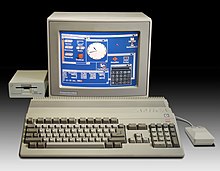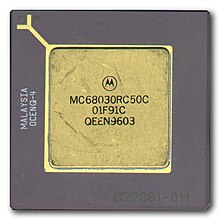AmigaOS
| AmigaOS | |
|---|---|

|
|
| developer |
Commodore Intl. (1.0-3.1), Haage & Partner (3.5-3.9), Hyperion Entertainment (3.1.4, 4.0-4.1) |
| License (s) | Proprietary |
| First publ. | July 23, 1985 |
| Current version | AmigaOS 4.1 Final Edition ( PPC ) December 18, 2014 ; AmigaOS 3.1.4 ( 68k ) September 30, 2018 |
| Kernel | Microkernel |
| ancestry |
TRIPOS ↳ AmigaOS |
| Architecture (s) | PowerPC , 68k |
| timeline | AmigaOS ...
|
| Others | Final Edition: 29.95 euros |
| amigaos.net | |
AmigaOS is the native operating system for the Commodore Amiga , which consists of the components Workbench , the AmigaDOS with the command line interpreter CLI (later renamed to Shell ) and the operating system kernel Kickstart, which is in the ROM of most Amiga models .
development
The system was developed by Amiga from 1982 to 1984 and the first version was completed after it was taken over by Commodore in 1985. The AmigaDOS component and parts of Kickstart are based on TRIPOS , a multi- user operating system from MetaComCo , which was developed in the BCPL programming language .
For its time, d. H. Between 1985 and 1992, AmigaOS had outstanding properties which, in combination, were not achieved by any other common operating system for a long time:
- 32-bit architecture
- preemptive multitasking similar to Unix computers (AmigaOS was, besides Unix, the only multitasking desktop operating system for many years)
- Microkernel architecture with reloadable shared libraries and device drivers (devices)
- Library calls with version control
- programmable real-time interrupts with low latency
- programmable file system devices
- Application-independent printer drivers - due to a lack of manufacturer support, a market for other manufacturers emerged. TurboPrint uses the resulting niche for Linux today .
- application-independent data type drivers. The exchange of data as a plug-in was regulated via DataTypes . The determination of the data type was also independent of the file name.
- window-oriented graphical user interface
- Mouse-oriented boot menu - if new hard disks with the operating system were added to the system, it asked which one the system was to be started from. The entire hardware detection ( AutoConfig of the Zorro bus - similar to PCI , at times when you typically had to change jumpers on IBM PCs ) took place very quickly even by today's standards.
- application-related desktops (so-called screens) in different graphic and color resolutions
- From version 2.1, international localization ( i18n ) is dynamically possible
- international 8-bit character set according to ISO 8859-1
- Complete abstraction of the data memory from the hardware: If data carriers are addressed by name, it is irrelevant in the case of removable data carriers which drive they are in, and if they are not logged in, they are requested by the user - this is the only form of this capability at AmigaOS.
- standardized process communication via ARexx , a highly compatible REXX variant.
The first Motorola 68k CPUs did not yet provide a memory management unit . Therefore AmigaOS had to get along without memory protection - which, however , was not an issue in the home computer segment in the mid-1980s either .
The workbench was not absolutely necessary for the functioning of the computer, since the operating system kernel and many system libraries were contained in the kickstart ROM, which is why many computer games were loaded directly from the kickstart in order to be able to use more main memory. However, this disabled the multitasking properties of the operating system.
Up to version 3.1 ( 1994 ) AmigaOS was developed by Commodore . Amiga Inc. and Haage & Partner were responsible for the development of versions 3.5 ( 1999 ) and 3.9 ( 2000 ) . Hyperion Entertainment then worked on AmigaOS 'version 4 on behalf of Amiga Inc., the first version of AmigaOS that no longer supports MC68000 processors, but runs exclusively on Motorola's PowerPC series. AmigaOS 4 is available for the PowerPC-based AmigaOne platform from Eyetech . At the same time, a version for traditional Amiga systems was worked on, which is equipped with a PowerPC processor expansion card. This has been delivered to end customers since December 3, 2007.
The version 4.1 announced by Hyperion Entertainment for the 3rd quarter of 2008 has been shipping since the beginning of September. The AmigaOne platform and, for the first time, the mainboards of the SAM440 series from ACUBE Systems are supported . For AmigaOne users this is the first update that is no longer available for free.
Since January 31, 2009, AmigaOS 4.1 has also been available for the Pegasos-II type mainboards .
Under AmigaOS4 programs for 68k Amiga are generally in an emulation for the function of the necessary running of the 68k processor compatibility also JIT compilation is used.
With the help of the GNU auxiliary programs, AmigaOS can be converted into a Unix-like operating system. The editor vim was developed in this context , and AmigaOS was also the main development platform for numerous GNU tools, including the GCC, for a time in the late 1980s and early 1990s .
Many graphics and multimedia programs that are available today for Windows and / or Mac come from the Amiga platform these days.
On December 18, 2014, Hyperion Entertainment announced the release and delivery of the latest version of the operating system called AmigaOS 4.1 Final Edition . This is available for the Amiga 1200, 3000 and 4000, AmigaOne XE, SE, MicroA1, Sam440 / 460, 500 and X1000 as well as Pegasos 2 devices.
On December 29th, 2015 the source code of AmigaOS 3.1 became available on the web ( leak ), confirmed by the rights holder Hyperion Entertainment.
Versions
See: Kickstart
Systems derived from AmigaOS
- MorphOS - An alternative to running 68k -AmigaOS-3.1 programs on current PowerPC - Hardware in the form of Pegasus -Rechnerfamilie is MorphOS. For the execution of native PowerPC software, AmigaOS 4 and MorphOS use different approaches that are not compatible with each other. By providing mutual emulation approaches ( OS4Emu or ppclibemu ), a third party is working on solutions that, due to the lack of willingness to officially cooperate, tend to lead a prototype niche existence.
-
AROS and AfA - The AROS project is an approach tosimulatea free AmigaOS 3.1 environment on x86 processors (and other CPUs ). With a precise mapping of the AmigaOS API , Amiga programs should be able to be ported to AROS by recompilation.
In the form of AfA (AROS for AmigaOS) there is also a project with which the aim is to make the innovations introduced by AROS available by backporting under AmigaOS and on the WinUAE emulation solution .
Programming interfaces
Internet
Hexagon = PowerPC native
Rectangle = No SANA-II
LAN
- Envoy
- Parnet (actually Peer-to-Peer )
graphic
2D:
- CyberGraphX ( phase5 ) by Frank Mariak
- Picture in picture cgxvideo.library
- Picasso 96 by Tobias Abt and Alexander Kneer
- Picture in picture Picasso96API.library
- EGS (obsolete) from Viona Development
3D:
- MiniGL from Hyperion Entertainment
- mglut.library
- Warp3D (low-level rasterizer) from Hyperion Entertainment
- Storm Mesa (agl.library) from Haage & Partner
- CyberGL ( phase5 ) by Frank Mariak
Audio
- AHI by Martin Blom
-
MIDI
- CAMD from Commodore
- midi.library by Bill Barton
- BlueRibbon.library from "Bars & Pipes"
- MHI by Paul Qureshi and Thomas Wenzel
- mpeg.device of the CD³²
- mpega.library by Stephane Tavenard
- toccata.library from MacroSystem
- maestix.library by Richard Körber
Video
- VHI from IOSPIRIT GmbH
- mpeg.device of the CD³²
- tv.library from Elbox Computer
- tvcard.library and valiantvision.library by Guido Mersmann
- p4specials.library from Village Tronic Computer
scanner
- BetaScan from SANE
- ScanQuix from RBM
GUI
- GadTools
- BGUI by Jan van den Baard
- Triton by Stefan Zeiger
- StormWIZARD from Haage & Partner
- Magic User Interface (MUI for short) by Stefan Stuntz
- ReAction (previously ClassAct)
- Feelin by Olivier Laviale
- OX by Andreas Szabo
bus
-
Zorro
- expansion.library
- PCI
- openpci.library by Benjamin Vernoux
- pci.library from Elbox Computer
- pcix.library and cybpci.library by Ralph Schmidt
- USB
- ANAIIS
- Poseidon
- Sirion
HDD
- Trackdisk 64-bit (TD64)
- New Style Device (NSD)
- Direct SCSI (HD_SCSICMD)
User administration
Commodore did not provide an interface, there is an alternative
- usergroup.library ( AmiTCP )
- accounts.library (Envoy)
- multiuser.library (muFS)
Virtual memory
Commodore did not provide an interface, there is an alternative
- vmem.library (GigaMem)
- vmm.library (VMM by Martin Apel)
- VMEM Evolution (MacroSystem)
text
Unicode
- charsets.library
- codesets.library (LGPL)
- utility.library V52
- uni.library
See also
literature
- Commodore-Amiga Inc., Reading MA
- The Amiga ROM Kernel Manual: Libraries . ISBN 0-201-56774-1 .
- The Amiga ROM Kernel Manual: Devices . ISBN 0-201-56775-X .
- The Amiga ROM Kernel Manual: Includes and Autodocs . ISBN 0-201-56773-3 .
- The Amiga User Interface Style Guide . ISBN 0-201-57757-7 .
- The AmigaDOS Manual . 3rd edition. ISBN 0-553-35403-5 .
- The Amiga Hardware Reference Manual . ISBN 0-201-18157-6 .
- Ralph Babel: The Amiga Guru Book . Self-published, Taunusstein 1993.
- Wilfried Häring: AmigaDOS 1.3. User and programmer's book . 2nd Edition. Markt-und-Technik-Verlag, Haar near Munich 1989, ISBN 3-89090-802-0 .
- Wilfried Häring: quick overview AMIGA DOS 1.3. Quick overview Amiga . Markt-und-Technik-Verlag, Haar near Munich 1989, ISBN 3-89090-730-X .
- Wilfried Häring: AMIGA OS 2.0. User manual. Operation of the workbench, operation of the shell (CLI), DOS reference part, batch programming, FastFileSystem, Linker, DOS editors, MEMACS, AREXX, AREXX for users . Markt-und-Technik-Verlag, Haar near Munich 1991, ISBN 3-89090-924-8 .
- Ralf Leithaus: AmigaDOS for users. A learning course not just for beginners . TechnicSupport, Berlin 1989, ISBN 3-926847-09-3 .
Web links
- AmigaOS 4 - official website (English)
- AmigaOS - unofficial website (German / English)
- Amiga Inc. (English)
Individual evidence
- ^ Native Development Kit 3.9
- ↑ Delivery of AmigaOS 4.1 Final Edition
- ↑ Michael Larabel: Hyperion Confirms Leak Of AmigaOS 3.1 Source Code . Phoronix . 5th January 2016.
- ↑ amiga-os-kickstart-and-workbench-source-coded-leaked on December 29, 2015





